Grimstad is a charming coastal town on Norway’s sunny south coast. From Ibsen’s legacy to the best walking routes, here is an introduction to Grimstad.
Before my recent trip to Grimstad, I knew the town as the home of one of my favourite Norwegian breweries and knew it had something to do with Henrik Ibsen. But that was all!
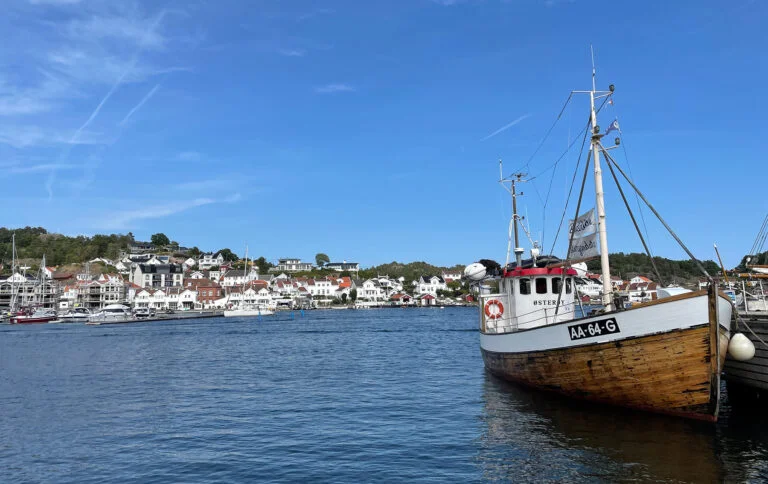
As it turns out, Grimstad is a lovely waterfront town typical of the southern Norway coastline. White houses, boats galore and some interesting history thrown in too.
Video Highlights of Grimstad
The best place to start is with this quick highlights video from Life in Norway's YouTube channel. I filmed it on a trip to Grimstad on a sunny weekend in 2022.
It’ll give you an idea of what to expect from a visit to Grimstad in just a couple of minutes. Enjoy!
Once you’ve watched the video, read on for more details and ideas about things to do in Grimstad. Let’s get going…
Where is Grimstad & How to Get There?
Grimstad is a charming town located on Norway’s southern coast, approximately 275 kilometers southwest of Oslo and just 47 kilometers east of Kristiansand, the largest city in southern Norway.
Getting to Grimstad from Oslo: The drive from Oslo to Grimstad takes about 3.5 hours via the E18 motorway, a scenic route that passes through rolling countryside and coastal towns.
Express coaches also run from Oslo to Grimstad, offering a convenient alternative to driving. However, note that these coaches typically stop at Øygardsdalen, just off the E18, which is about a 25-minute walk from Grimstad’s town centre.
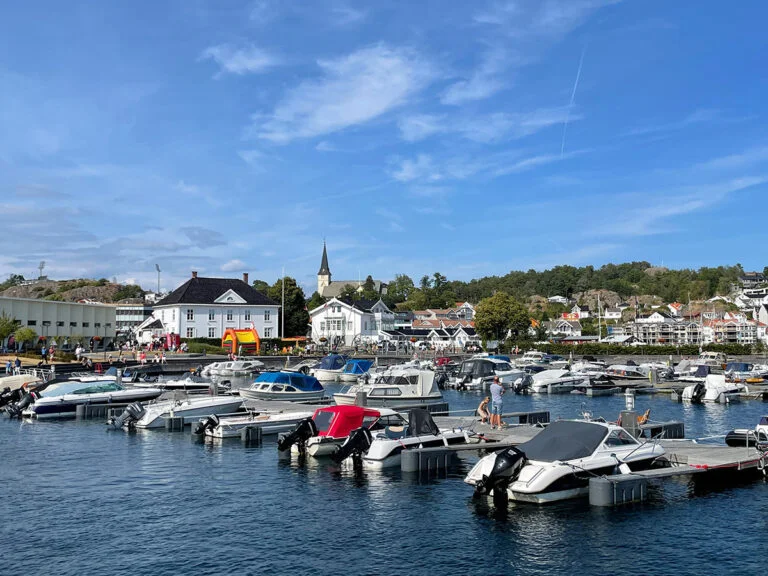
While it’s technically possible to visit Grimstad as a day trip from Oslo, the travel time makes it challenging to fully enjoy the town's attractions in a single day. An overnight stay is recommended, allowing you to explore Grimstad at a leisurely pace.
You could also extend your trip to visit nearby coastal towns like Lillesand, Arendal, or Risør, all of which offer their own unique charm.
Getting to Grimstad from Kristiansand: From Kristiansand, Grimstad is just a short 35-minute drive along the E18, making it an ideal day trip or stop on a longer southern Norway itinerary.
Local buses operate regularly between Kristiansand and Grimstad, with the added advantage of stopping in the town centre. This makes public transport a convenient option if you’re not driving.
Grimstad Town Centre
Once in Grimstad, the best way to get acquainted with the town is simply to walk around. From the main central shopping centre Odden to the church via the harbours and central shopping area takes no more than 15 minutes.
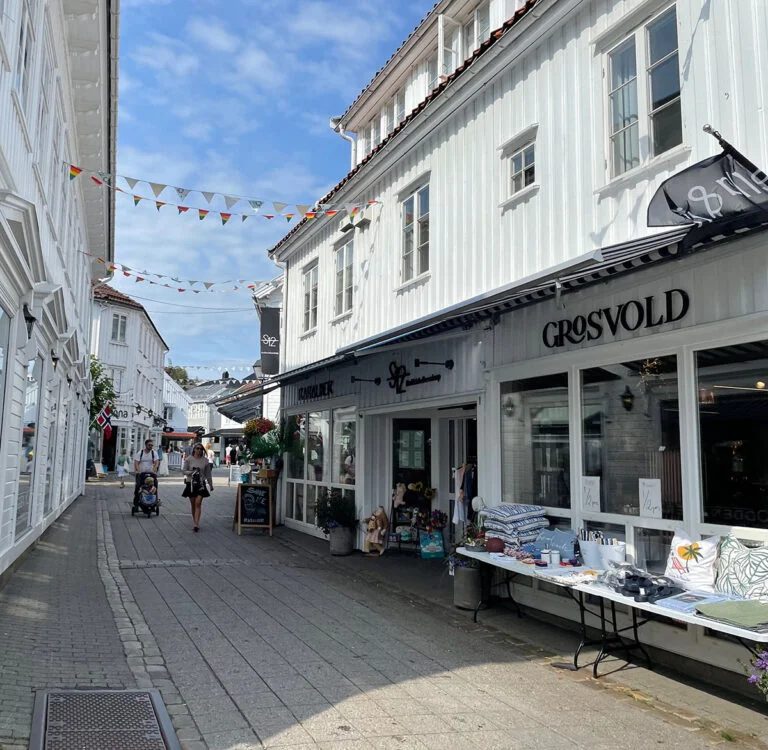
Or at least, it does if you walk directly. But on a summer’s day it’s very hard not to get sidetracked! Grimstad is full of harbour views, alleyways and stairways just begging to be explored.
The pedestrian streets of the compact town centre are a lovely place for a stroll. It’s easy to get lost amid the alleyways and countless white wooden buildings, but it’s such a small place that you won’t be lost for long!
Alleys and Stairways of Grimstad
One thing you’ll quickly notice is the number of stairways dotted around the central area. Most are marked as a ‘snarvei’, which means shortcut in Norwegian. Thanks to the wonders of Google, I found out more about these curious routes.
The words of local historian Halfdan Gundersen are the best to describe the somewhat chaotic layout of central Grimstad:
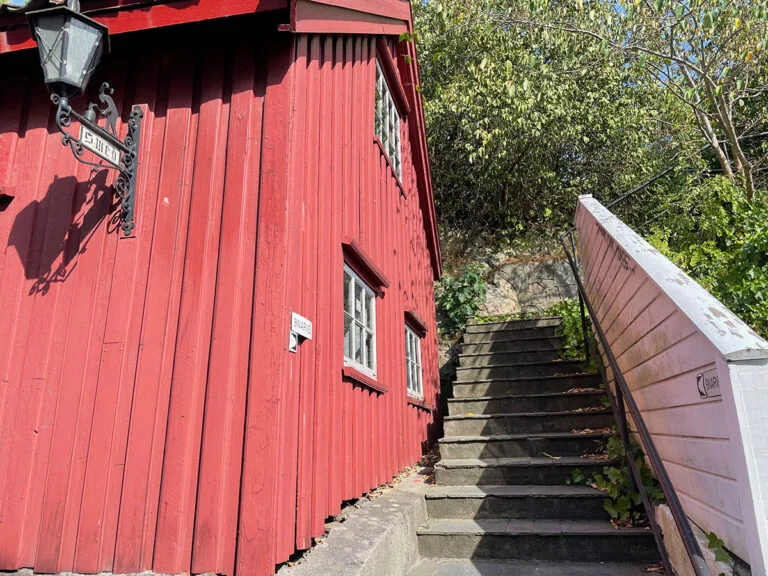
“As you can imagine, the public roads were in a relatively primitive state in the beginning. The town had more or less built itself up and the houses were scattered here and there like in a coastal village. Gradually a settlement emerged along the narrow alleyways that gradually became streets.”
“The town developed on this irregular basis, and since it was not exposed to the devastating but regulating influence of fire like most other wooden towns, you can still discover the crooked and mostly narrow streets between the houses today.”
The Ibsen Legacy
Henrik Ibsen (1828–1906), one of the world’s most influential playwrights and often referred to as the “father of modern drama,” has deep ties to Grimstad.
Although he spent his childhood in Skien, Ibsen moved to Grimstad as a young man to work as an apothecary’s assistant. It was here that his literary journey began—he wrote his very first play, Catilina, during his time in Grimstad, inspired by the town's surroundings and perhaps the people he met.
He also penned numerous poems, many of which were dedicated to local girls, giving us a glimpse into the youthful, romantic side of the man who would later write darker, more complex works.
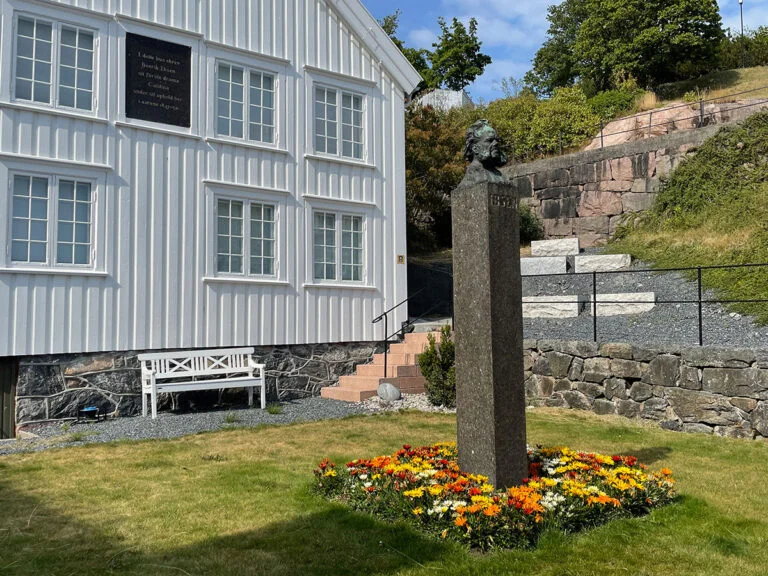
Today, Ibsen’s legacy is cherished in Grimstad. The pharmacy where he worked has been transformed into the Ibsen Museum, a must-visit for literature enthusiasts.
The museum offers guided tours during the summer months, allowing visitors to step back in time and learn more about Ibsen’s formative years and his connection to the town.
Henrik Ibsen isn’t the only literary figure with ties to Grimstad. Knut Hamsun, another giant of Norwegian literature, also called Grimstad home.
Hamsun’s literary achievements were recognised on an international scale when he was awarded the Nobel Prize in Literature in 1920 for his novel Growth of the Soil, a work that celebrated rural life and the human connection to the land.
While Hamsun’s legacy is complicated due to his controversial political views later in life, his contribution to Norwegian literature remains undeniable. Together, Ibsen and Hamsun highlight Grimstad’s historical role as a haven for creativity and storytelling.
Grimstad Church
One of four churches in the town, Grimstad Church is a prominent landmark that’s hard to miss. Towering over the town from its perch atop a hill, the church can be seen from various vantage points, making it a key feature of Grimstad’s skyline.
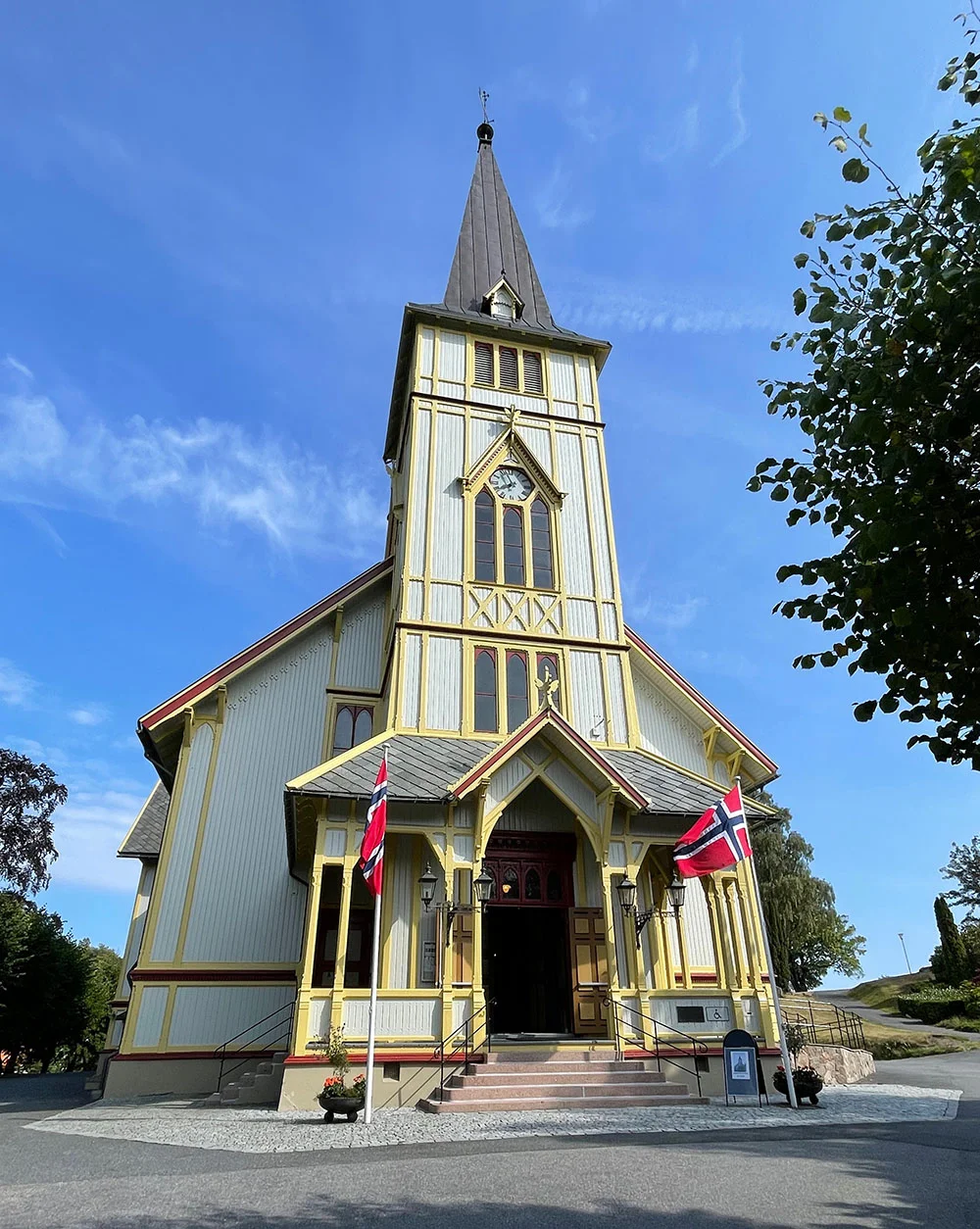
Constructed in 1881, this striking wooden church is painted in a distinctive light green with contrasting yellow and red ochre trim.
These bold colours were selected during a restoration in the 1960s, based on findings that the church’s original paintwork from the late 19th century was indeed light green. The vibrant façade gives the church a unique charm, blending tradition with a sense of whimsy.
For a town as small as Grimstad, the size of the church is surprisingly impressive. It can accommodate up to 1,000 people, reflecting its historical role as a gathering place for the local community.
However, visitors may find it much quieter today. On a sunny Sunday afternoon, I was the sole visitor.
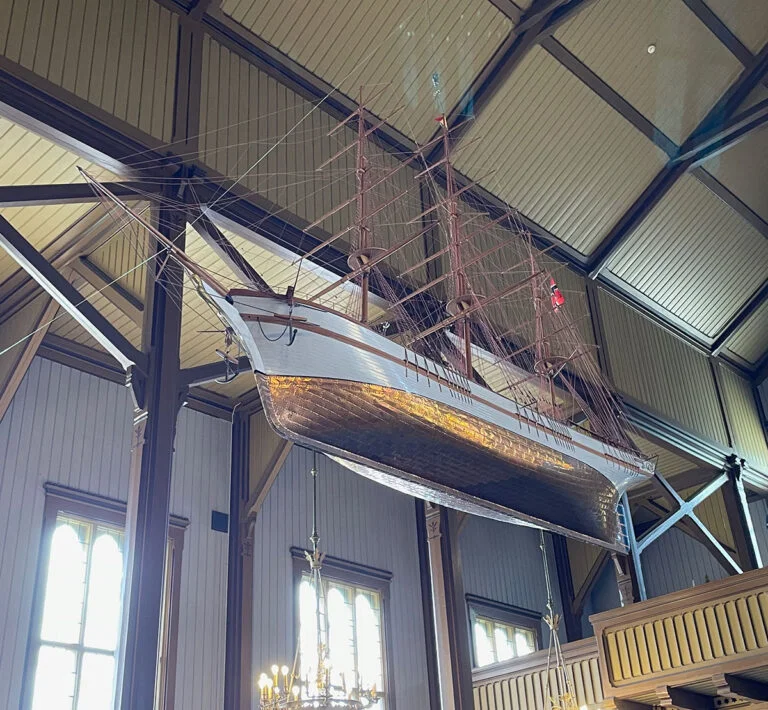
Perhaps the most eye-catching feature of the interior is the model sailboat suspended from the ceiling, a nod to Grimstad’s maritime heritage. This small touch reinforces the town’s deep connection to the sea and serves as a reminder of the sailors and shipbuilders who shaped Grimstad’s history.
Other Things To Do in Grimstad
Aside from the Ibsen musuem and Grimstad church, there are some other things to do in Grimstad:
Nøgne Ø: As I mentioned in the introduction, one of the few reasons I knew of Grimstad was its brewery, Nøgne Ø. Although enjoyed all over Norway, Nøgne Ø beers are easy to find in the bars and restaurants of Grimstad. By the way, the name means “naked isle” in Norwegian, and comes, of course, from Ibsen.
Maritime Museum: The Maritime Museum in Grimstad offers a glimpse into the town's seafaring past. Located in the Hasseldalen area, which was a hub of shipbuilding and shipping activity for over 150 years, the museum preserves and celebrates the region’s maritime heritage.
Exhibits focus on the age of sail, when wooden ships and wind power dominated global trade and exploration. Visitors can learn about shipbuilding, the challenges of navigation, and the daring spirit of those who sought to conquer the seas.
Hasseldalen itself is steeped in history. Once home to bustling shipyards, it played a vital role in Grimstad’s economy and identity during the height of the sailing ship era. Today, the Maritime Museum ensures that this legacy is not forgotten.
Grimstad archipelago: This string of rocky islands and skerries with secluded beaches are within sight of Grimstad. Locals putter to and from the islands in their own boats, but what’s a tourist to do?
There are several options for touring the archipelago. The schooner Solrik and old fishing vessel Østerøy are popular, but there’s also the opportunity to rent your own boat and kayak. There’s also a taxi boat which can be rented for groups as a sightseeing tour.
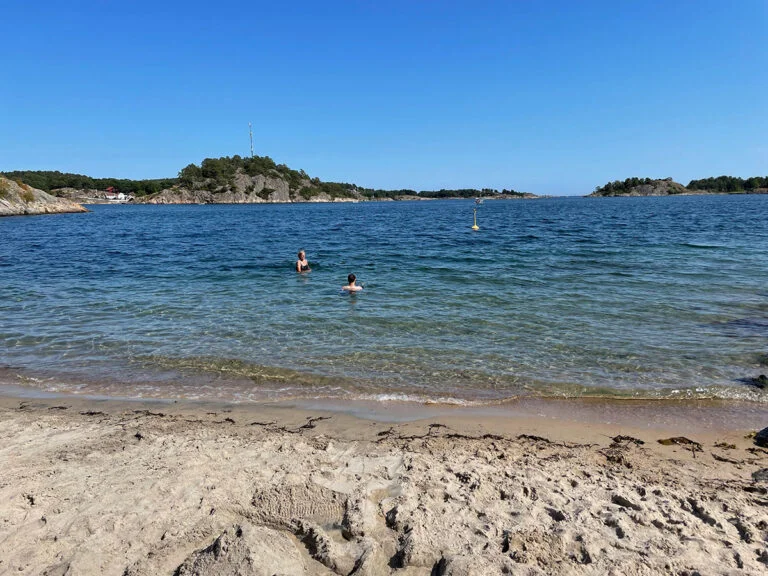
Town beach: Southern Norway is known for its coastline and beaches. Slightly out of the way, the town beach is a pleasant spot but very small. Most people seem to prefer lounging about on the grass, venturing down to the sand only when they fancy a paddle.
Jerv FK: You could always do as I did and catch a football game. Local club Jerv play at the Levermyr stadion. Unfortunately since I visited, the club has dropped into the third tier of Norwegian football.
Food & Drink in Grimstad
While in Grimstad, there are a couple of local specialities you should seek out. One is of course a beer from Nøgne Ø. But as for snacks, here are a couple of suggestions.
Hot dogs: To locals, Grimstad is known just as much for its pølser (hot dog sausages) as it is Ibsen. You can’t miss the legendary red Nottos hot dog stall on the waterfront. It was also one of the few places I was able to get something to eat at around 10pm!
Porke: The Grimstad take on the humble skolebolle, a pastry with egg custard at its centre, covered in coconut. Several cafes in the town serve the popular local snack.

